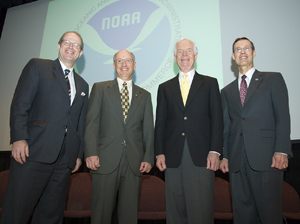Director of GRI to Serve as Director of the NOAA Northern Gulf Institute
November 16, 2006
MSU's Colin Scanes and David Shaw (from left) with Sen. Thad Cochran, R-Miss., and NOAA administrator Conrad C. Lautenbacher Jr.
Photo by: Russ Houston
The National Oceanic and Atmospheric Administration (NOAA) announced it is providing a first-year grant of $6.3 million to a consortium of universities and institutions in Florida, Alabama, Mississippi, and Louisiana to create the Northern Gulf Institute. Funding will then increase to just under $10 million a year over the remaining five years of the contract period. Escalating economic benefits are anticipated for the entire area as storm-forecasting will be a major function of the institute.
Mississippi State University will serve as lead institution for the institute based at the Stennis Space Center in Hancock County, Mississippi. Other institutional players include the University of Southern Mississippi, Florida State and Louisiana State University, and Alabama's Dauphin Island Sea Laboratory.
GRI, directed by David Shaw, will apply its cutting-edge spatial and modeling technologies to improve storm forecasting. It also will address a wide range of other critical environmental issues in the northern Gulf of Mexico region, which stretches from the Sabine River on the west to the Suwannee River on the east. The strengths of the participating institutions will strongly complement GRI's expertise in high-performance computing, geospatial technologies, and watershed and atmospheric modeling.
"We need to do a better job of managing our inland resources to preserve the Gulf Coast ecosystem," said Shaw, who led a feasibility study for the proposed project last year. "We also need to look at how we can do a better job of predicting storm activity, particularly hurricanes in the Gulf."
NOAA administrator Conrad C. Lautenbacher Jr., a retired U.S. Navy vice admiral, said NOAA scientists and university researchers will collaborate to study regional issues associated with coastal hazards, climate change, water quality, ecosystem management, coastal wetlands and pollution.
"This will benefit the residents of the region and also support NOAA's participation in the president's U.S. Ocean Action Plan," predicted Lautenbacher, who also serves as under secretary of commerce for oceans and atmospheres.
Shaw said the U.S. Commission on Ocean Policy "endorsed the concept of establishing the Gulf of Mexico as a priority" for scientific research two years ago.
Responding to that 2004 report, Mississippi Gov. Haley Barbour urged NOAA and the Navy to "establish a prototype joint ocean and coastal information management system at Stennis to build on the successful programs already extant there"--including NOAA's National Coastal Data Development Center and National Data Buoy Center.
The Gulf of Mexico ecosystem encompasses 1.8 million square miles and is the receiving body for 66 percent of the rivers within the continental United States--including the Mississippi River, the largest river system in North America. Specific issues of concern in the Gulf region include nutrients, habitat, public health, environmental monitoring, modeling, storm forecasting, and other research.
For more information, contact Dr. Shaw at 662-325-9575 or dshaw@gri.msstate.edu.
The full article can be found at Mississippi State University News
NOAA's official Press Release about the NGI can be found at www.publicaffairs.noaa.gov/releases2006/nov06/noaa06-r915.html
